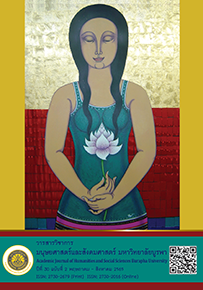The Creative Attributes of Thai Television Drama and Audience Satisfaction: A Case Study of Love Destiny Television Drama
Main Article Content
Abstract
The television drama Love Destiny has widely created the intense Thainess trend in society, encouraging various audience behaviors called ‘Aor Jao Phenomenon.’ This unprecedented phenomenon is the effect of audience satisfaction that this drama gave. Thai television drama makers could use this drama as a model for producing television shows that attract a mass audience. Therefore, this research aims at studying the correlation between each creative component of Thai television drama and audience satisfaction, using Love Destiny as a case study. This survey research used an online questionnaire as a main method of data collection. The results showed that all creative components correlated with audience satisfaction. The six components, consisting of screenplay, casts and acting, costume design, production design, special effects, and public relations, were statistically linked to the audience satisfaction.
Downloads
Article Details

This work is licensed under a Creative Commons Attribution-NonCommercial-NoDerivatives 4.0 International License.
บทความทุกบทความเป็นลิขสิทธิ์ของวารสารวิชาการมนุษยศาสตร์และสังคมศาสตร์ มหาวิทยาลัยบูรพาเท่านั้น
References
กฤติญา รุ่งกาญจนาพร. (2550). ความพึงพอใจของประชาชนในการรับชมละครโทรทัศน์ ในเขตบางกะปิ กรุงเทพมหานคร. [วิทยานิพนธ์ศิลปศาสตรมหาบัณฑิต, มหาวิทยาลัยรามคำแหง]. https://doi.org/10.14457/RU.the.2007.163
ข่าวไทยพีบีเอส. (2561, 4 เมษายน). “บุพเพสันนิวาส” สร้างโอกาสในแสงริบหรี่วงการหนังสือไทย. ไทยพีบีเอสออนไลน์. https://news.thaipbs.or.th/content/ 271433
คันธิยา วงศ์จันทา. (2541). การพัฒนาเกณฑ์หรือตัวบ่งชี้คุณภาพรายการละครโทรทัศน์. [วิทยานิพนธ์นิเทศศาสตรมหาบัณฑิต, จุฬาลงกรณ์มหาวิทยาลัย].
เณริศา ชัยศุภมงคงลาภ. (2563). ความสำเร็จของละครโทรทัศน์กับการสร้างปฏิสัมพันธ์ ทางสังคมกึ่งความจริง กรณีศึกษาละครโทรทัศน์บุพเพสันนิวาส. วารสารนิเทศศาสตร์ธุรกิจบัณฑิตย์, 14(1), 158-198.
ทิพาภัสสร์ คล้ายจันทร์ และธีรเดช ชื่นประภานุสรณ์. (2560). ความพึงพอใจของผู้ชมและแนวโน้มของละครโทรทัศน์หลังข่าวของช่อง 7 สี ในเขตกรุงเทพมหานคร. วารสารวิชาการบัณฑิตวิทยาลัยสวนดุสิต, 13(2), 281-292.
ไทยรัฐออนไลน์. (2561, 4 เมษายน). “บุพเพสันนิวาส” พิมพ์ 1 แสนเล่มแล้วนะออเจ้า. https://www.thairath.co.th/business/market/1247831
เฟื่องฟ้า โพธิ์เจริญ. (2551). ความพึงพอใจของผู้ชมที่มีต่อละครโทรทัศน์ทางสถานีไทยทีวีสีช่อง 3 ในเขตบางกะปิ กรุงเทพมหานคร. [วิทยานิพนธ์ศิลปศาสตรมหาบัณฑิต, มหาวิทยาลัยรามคำแหง]. https://doi.org/10.14457/RU.the.2008.125
ภัทรภร เสนไกรกุล และจิรยุทธ์ สินธุพันธ์. (2562). บุพเพสันนิวาส: ความรู้สึกร่วมกับ การตามรอยของผู้ชมละครไทย. ใน การประชุมทางวิชาการของมหาวิทยาลัยเกษตรศาสตร์ ครั้งที่ 57: สาขาศึกษาศาสตร์, สาขาเศรษฐศาสตร์และบริหารธุรกิจ, สาขามนุษยศาสตร์และสังคมศาสตร์ (หน้า 463-471). สำนักงานกองทุนสนับสนุนการวิจัย. https://doi.org/10.14457/KU.res.2019.183
ภัทรเวช ฟุ้งเฟื่อง และดวงกมล ชาติประเสริฐ. (2562). ความคาดหวังและความพึงพอใจของผู้ชมละครโทรทัศน์ “บุพเพสันนิวาส.” วารสารสถาบันวิจัยและพัฒนา มหาวิทยาลัยราชภัฏบ้านสมเด็จเจ้าพระยา, 4(2), 123-141.
สรรัตน์ จิรบวรวิสุทธิ์. (2554). พัฒนาการและสุนทรียทัศน์ในการสร้างสรรค์บทละครในโทรทัศน์ไทย. [วิทยานิพนธ์นิเทศศาสตรมหาบัณฑิต, จุฬาลงกรณ์มหาวิทยาลัย].
สรรัตน์ จิรบวรวิสุทธิ์ และปรีดา อัครจันทโชติ. (2563). การประกอบสร้างและการสื่อความหมายของความทรงจำร่วมในละครโทรทัศน์อิงประวัติศาสตร์ของไทย. วารสารนิเทศสยามปริทัศน์, 19(2), 8-29.
สินีนาฏ สีสรรค์. (2552). พฤติกรรมการเปิดรับชมด้วยความพึงพอใจของผู้ชมในกรุงเทพมหานครที่มีต่อละครโทรทัศน์หลังข่าว. [วิทยานิพนธ์ศิลปศาสตรมหาบัณฑิต, มหาวิทยาลัยรามคำแหง]. https://doi.org/10.14457/RU.the.2009.174
องอาจ สิงห์ลำพอง. (2550). การสร้างเกณฑ์มาตรฐานการผลิตละครโทรทัศน์ไทย. [วิทยานิพนธ์นิเทศศาสตรมหาบัณฑิต, จุฬาลงกรณ์มหาวิทยาลัย].
Dennis, D. M., & Gray, D. M. (2013). An episode-by-episode examination: What drives television-viewer behavior - digging down into audience satisfaction with television dramas. Journal of Advertising Research, 53(2), 166-174. https://doi.org/10.2501/JAR-53-2-166-174
Gray, D., & Dennis, D. (2010). Audience satisfaction with television drama: A conceptual model. In P. Ballantine, & J. Finsterwalder (Eds.), Proceeding of the ANZMAC 2010: Doing More with Less. University of Canterbury.
http://anzmac2010.org/proceedings/pdf/anzmac10Final00397.pdf
Lu, X., & Lo, H-P. (2007). Television audience satisfaction: Antecedents and consequences. Journal of Advertising Research, 47(3), 354-363. https://doi.org/10.2501/s0021849907070365
Millerson, G., & Owens, J. (2009). Television production (14th ed.). Focal Press.
Patwardhan, P., Yang, J., & Patwardhan, H. (2011). Understanding media satisfaction: Development and validation of an affect-based scale. Atlantic Journal of Communication, 19(3), 169-188. https://doi.org/10. 1080/15456870.2011.584508
TV Digital Watch. (2561, 12 เมษายน). บทสรุป “บุพเพสันนิวาส”. https://www.tvdigitalwatch.com/analysis-buppesanniwas-12-05-61/
Zettl, H. (2006). Television production handbook (9th ed.). Thomson Wadsworth


